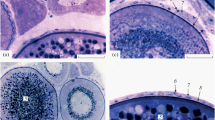Summary
On the basis of histological and experimental studies involving blood transfusions, injection of ovarian extracts, and transplantation of neurosecretory cells, it is concluded that there is an endocrine basis for oviposition in the insectIphita limbata Stal. (Pyrrhocoridæ: Hemiptera), a common plant bug of South India. Oviposition is brought about in the gravid female by a hormone-complex involving the interaction between the ovary and the neurosecretory system. It is tentatively postulated that it probably works out as follows:
Stainable neurosecretory matter from the cells of the pars intercerebralis of the brain passes along the axons of the allatic nerve to the corpus allatum. This stimulates the gland which consequently begins to enlarge and initiates egg-growth by deposition of yolk. When eggs become full grown and ripe,i.e., when the animal becomes gravid, the ovarian wall releases a substance into the blood which may be presumed to exert a dual action on the neurosecretory system. Evidences show that the supply of visible, stainable, neurosecretory colloids to the corpus allatum is reduced or inhibited, which may result in an inactivation of the gland and stops further elaboration of yolk in the eggs. At the same time, the blood-borne factor influences the cells of the pars intercerebralis to release their colloids into blood. This release of neurosecretory matter may have a role in inducing oviposition by promoting oviducal contractions.
Similar content being viewed by others
References
Arvy, L., Bounhiol, J. J. and Gabe, M.C.R. Acad. Sci., Paris, 1953,236, 627–29.
Altmann, G...Zeit. Bienforsch., 1950,1, 24–32.
—————.. Ibid., 1952,1, 124–27.
Bodenstein, D. ..Insect Physiology, Chapter 32, Edited by K. D. Roeder, New York, 1953.
—————..Recent Progress in Hormone Research, 1954,10, 157–82.
Von Buddenbrock, W...Vergleichende Physiologie, 1950,4, 421–27.
Dupont-Raabe, M...Bull. Soc. Zool. France, 1951,76, 386–97.
—————..Arch. Zool. exp. Gen., 1952,89, 128–38.
Enders .. Scharrerin litt., 1955.
Harris, G. W. ..Neural Control of the Pituitary Gland, London, Chapter 10, 1955.
Johansson, A. S...Nature, 1954,174, 89.
—————..Biol. Bull., 1955,108, 40–44.
Joly, P...Arch. Zool. exp. Gen., 1945,84, 49–164.
Koller, G. ..Verh. der Dtsch. Zool. Tubingen, 1954, no volume number, 417–22.
Luscher, M. and Engelmann, F.Rev. Suisse Zool., 1955,62, 649–57.
Marshall, F. H. A. and Moir, J. C. in Marshall’sPhysiology of Reproduction, Chapter 19, Ed. A.S. Parkes, 1952,2, London.
Meyer, R. K. and McShan, W. H.Recent Progress in Hormone Research, 1950,5, 465–515.
Nayar, K. K...Curr. Sci., 1953,22, 149.
—————..Biol. Bull., 1955a,108, 296–307.
—————..Proc. Ind. Acad. Sci., 1955b,42, 27–30.
—————..Curr. Sci., 1955c,24, 306–07.
—————..Zeits. Zellf., 1956a,44, 697–705.
—————..Quart. J. micr. Sci., 1956b,97, 83–88.
—————..Proc. Nat. Inst. Sci. India, 1956c,22 B, 171–84.
----- ..Proc. Second Internat. Symp. Neurosecretion, 1957 (in Press).
Pantin, C. F. A. ..Notes on Microscopical Technique, Cambridge, 1948.
Pfieffer, I. W...J. Exp. Zool., 1939,82, 439–61.
—————.. Ibid., 1945,99, 183–233.
Scharrer, B...Endocrinology, 1946,38, 46–55.
—————..Hormones, 1948,1, 121–58.
—————.. Ibid., 1955,3, 57–95.
—————..Ann. des. Sci. Nat. Zool., 1956,11, 231–34.
Scharrer, E. and Scharrer, B...Handb. mikr. Anat. Menschen., 1954a,6/5, 953–1066.
—————..Recent Progress in Hormone Research, 1954b,10, 183–240.
Southwood, T. R. E...Trans. Roy. Ent. Soc., London, 1956,108, 163–221.
Thomsen, E...Vidensk. Medd. Dansk. naturh. Foren., Kobenhaven, 1942,106, 319–415.
—————..J. Exp. Biol., 1952,29, 137–72.
—————.. Ibid., 1954,31, 322–30.
Vaidya, V. G...J. Bombay Nat. Hist. Soc., 1956,54, 216–17.
Vogt, M...Archiv. Entw. mech. Org., 1941,141, 424–54.
—————..Biol. Zbl., 1943,63, 467–70.
Wigglesworth, V. B...Quart. J. micr. Sci., 1936,79, 91–121.
—————..J. Exp. Biol., 1952,29, 620–31.
----- ..The Physiology of Insect Metamorphosis, Cambridge, 1954.
Author information
Authors and Affiliations
Additional information
Communicated by Dr. C. S. Venkateswaran,f.a.sc.
Rights and permissions
About this article
Cite this article
Nayar, K.K. Studies on the neurosecretory system ofIphita limbata stal. Proc. Indian Acad. Sci. 47, 233–251 (1958). https://doi.org/10.1007/BF03051566
Received:
Issue Date:
DOI: https://doi.org/10.1007/BF03051566




